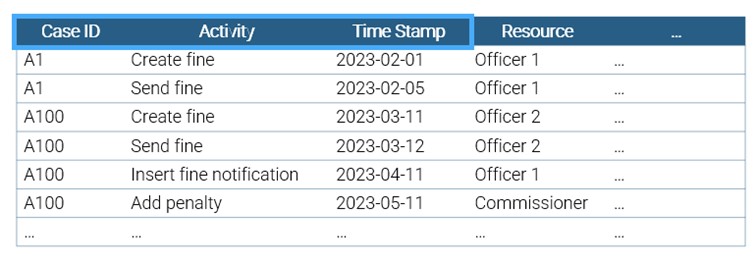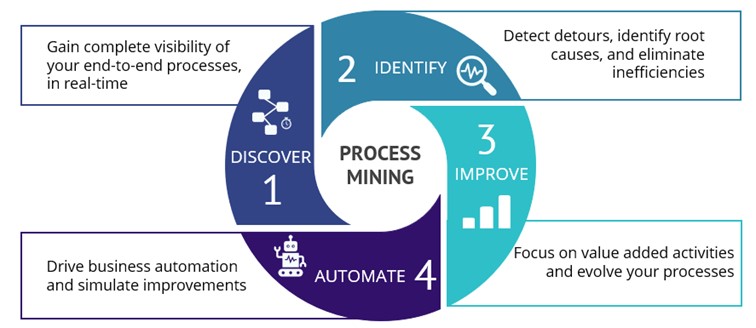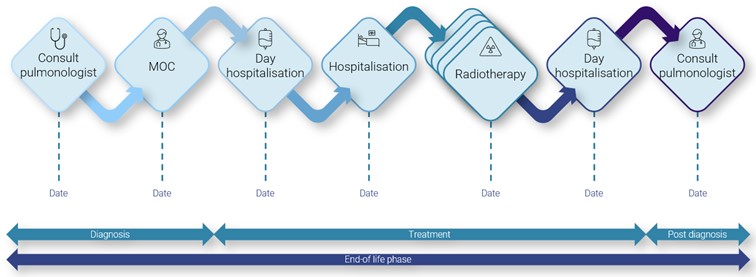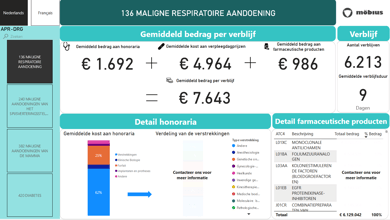We currently navigate an unpredictable and highly competitive business environment, where customers can easily seek alternative solutions. Every interaction with your customers is now scrutinised, demanding high-quality engagement every time.
Simply having the best product isn’t sufficient anymore. If competitors can offer a similar solution faster, cheaper, and more convenient, it poses a significant challenge. As a result, your business processes are becoming more and more a distinguishing factor.
To improve your business, process enhancements are key. However, pinpointing where a process fails and how it can be enhanced is not a straightforward task. It involves identifying, modeling, analysing, and monitoring existing business processes. Fortunately, process mining facilities support this task by leveraging readily available data from your systems and applications.
What is process mining?
Process mining is a technique designed to discover, improve, and monitor processes by using event log data. Each interaction with any of your business intelligence (BI) systems leaves digital traces behind, event log data. Process mining functions as an X-ray, it extracts the traces and creates a living picture of what your processes look like.

Even log data constitutes of at least 3 data points: a case ID, an activity label, and a time stamp. Based on these data points, process mining algorithms or software will recreate the process flow of each instance that can be analysed. Other data points to support your analysis, such as costs, resources, and suppliers are possible as well.

Process mining offers you an objective and real-time picture of your business processes and allows you to realise a more efficient and effective business execution. It also enables you to pinpoint hidden problems and quantify the added value of all activities involved or which ones to automate. Since it taps in on your current data sources there is no need to rip-and-replace current systems, rather you can leverage technology investments already made. Additionally, it allows for simple scaling by just adding extra data sources.

BPM – Embrace the power of data with process mining
The goal of business process management (BPM) is to identify, design, control, and renew processes from strategy and policy, to continuously add value to the customer. Process mining takes a data-driven approach to BPM. As a result, it offers numerous advantages during various phases of a traditional process lifecycle.
.png?width=2646&height=1209&name=ProcessMiningBlog%20(1).png)
Process discovery
During the process discovery phase, a primary challenge lies in accurately pinpointing the true process end-to-end, encompassing all deviations and exceptions encountered during execution.
Even in seemingly straightforward processes, numerous deviations appear in most organisations. Although these exceptions are often hidden, process mining can reveal them by accurately tracking each activity step by step. Consequently, process mining facilitates the creation of an objective, real-time, and system-agnostic perspective of your process.
Process analysis and redesign
Process mining conducts a comprehensive analysis of a particular process, deconstructing it to its essence in terms of all activities and instances it entails. This detailed data provides useful information to drive process improvements.
Process mining has proven to be incredibly useful in finding bottlenecks, abnormalities, and hidden problems that wouldn’t be revealed otherwise. Or even if they were recognised, the lack of quantitative data may hinder understanding their impact and effectively addressing them without unintentionally introducing new problems.
Augmenting the process model with data enables the quantification of path frequencies, throughput times, identification of bottlenecks, and other relevant information. When combined with business expertise, this data-driven approach provides an in-depth perspective of the current state, of the AS-IS, and facilitates the prioritisation of improvements. Transitioning to the desired future state, the TO-BE, simulations can be conducted to provide the impact of the improvements.
Process implementation
This phase is not directly impacted by process mining. However, it is key that process performance metrics are understood, and agreed upon that the mechanism to track them is put in place. This way you can use process mining to monitor the process execution.
Process monitoring and controlling
After implementation monitoring the compliance of the process over time is a crucial part of effective BPM. Since process mining provides a real-time picture of your process, it is ideal for monitoring. Combined with automated measures, in case of non-compliance, you can take corrective measures to adhere to the intended procedure.
Typical use cases
Every process supported by a BI system that registers transactional data can be analysed with process mining. Think about a process supported by an ERP or CRM system that contains information about the different activities that took place for a certain instance.
Use case 1: Working capital optimisation
Working capital is the difference between an organisation’s assets and liabilities. In other words, it represents the amount of cash that a company has available to run its day-to-day operations.
Optimising working capital involves efficient inventory management, accounts receivable (AR), and payable (AP). AR, AP, and inventory processes contain thousands of opportunities, but siloed systems and increased complexity make it difficult to identify these.
Where to start? How to gain transparency? What will have the biggest impact?
Accounts payable
Process mining offers a pathway to enhance on-time payments while reducing operational costs, by data centralisation across source systems, and streamlining process execution. It shows exactly where your bottlenecks are and what you can automate to reduce the workload for your finance department.
Accounts receivables
Process mining visualises which accounts are at risk and where the action is needed. Or, let the system send automated reminders if based on historic data action is needed. Intelligently prioritise claims outstanding to ensure on-time payment.
Inventory management
Analyse material movements upstream and downstream and replenish them based on true consumption.
Use case 2: Customer experience
As already mentioned, in today’s highly competitive environment every customer interaction counts. Customer journeys are a valuable tool for assessing your customer interaction and how to improve it. Process mining enables you to extract data from your CRM – customer relationship management, IVR – interactive voice response, HIS – hospital information system… and create the customer journey of your clients. When you compare the intended and actual flow, there can be many detours that lead to a diminished customer experience.


Use case 3: Digital transformation
The core objective of digital transformation is to reduce the amount of manual work, making processes faster and smarter. However, a digitalisation trajectory is expensive and it is a major challenge to determine where new technologies are an added value. Process mining can support digital transformation in several ways, from streamlining your processes and reducing inefficiencies to visualising automation possibilities. It allows you to analyse the AS-IS situation and identify the processes that are ready for transformation and which of them promises the highest ROI.
Process mining also identifies which parts of the process can and should be automated. The value of RPA is clear, but its implementation is less so. RPA only has value for high-volume tasks performed repeatedly. Instead of guessing if a task is performed enough to justify the investment in RPA, quantify it with process mining.
To conclude
In today's business, a great information disconnect exists - departments struggle to communicate, systems don't work well together, and subsequently, processes go haywire.
As a result, the happy flow of a process is just one of many hidden detours. This leads to lost value, low efficiency, unmet customer needs, and greater environmental and resource burdens.
Process mining is a powerful tool to solve this disconnect. It acts as a connector between systems, programs, processes, and people.
How we improved the hiring process of Proximus with process mining






